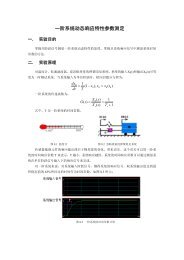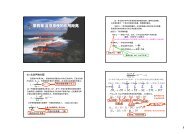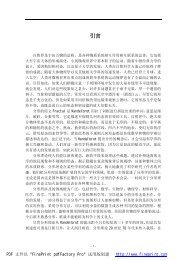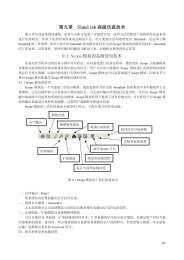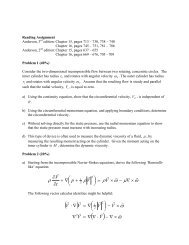Assume that the local skin friction coefficient in turbulent flow is ...
Assume that the local skin friction coefficient in turbulent flow is ...
Assume that the local skin friction coefficient in turbulent flow is ...
- No tags were found...
Create successful ePaper yourself
Turn your PDF publications into a flip-book with our unique Google optimized e-Paper software.
Problem 3Start<strong>in</strong>g from <strong>the</strong> <strong>in</strong>compressible Navier-Stokes equations derived <strong>in</strong> Problem 1, derive <strong>the</strong>follow<strong>in</strong>g equation for <strong>the</strong> evolution of <strong>the</strong> vorticity:rDωr r2r= bω⋅∇ gV+ ν∇ωDtProblem 4p aυ wp bLConsider <strong>the</strong> 2-D <strong>flow</strong> between two porous walls of length L at y =± h. <strong>Assume</strong> <strong>that</strong> <strong>the</strong> lengthof <strong>the</strong> walls <strong>is</strong> much larger than <strong>the</strong> half-height h so <strong>that</strong> <strong>the</strong> <strong>flow</strong> may be assumed to be constant<strong>in</strong> <strong>the</strong> x-direction. The upper wall produces a suction such <strong>that</strong> <strong>the</strong> velocity normal to <strong>the</strong> wall <strong>is</strong>υ wand <strong>is</strong> positive. Solve <strong>the</strong> <strong>in</strong>compressible Navier-Stokes equations to f<strong>in</strong>d <strong>the</strong> velocity andpressure everywhere <strong>in</strong> duct for <strong>the</strong> case <strong>in</strong> which <strong>the</strong> pressure <strong>in</strong>let and exit of <strong>the</strong> pipe arep aand p b, respectively. Specifically, you should f<strong>in</strong>d <strong>the</strong> follow<strong>in</strong>g solution for <strong>the</strong> x-velocity:uu0FHGRe Re2 y e − e yh= − 1+Re h s<strong>in</strong>h Rewhere u 0<strong>is</strong> a constant <strong>that</strong> you must determ<strong>in</strong>e as part of <strong>the</strong> solution and <strong>the</strong> Reynolds number<strong>in</strong> th<strong>is</strong> problem <strong>is</strong> def<strong>in</strong>ed asRe = υ h wνIKJShow <strong>that</strong> for <strong>the</strong> case of low Reynolds number (i.e. small blow<strong>in</strong>g), <strong>the</strong> solution returns to <strong>the</strong>parabolic velocity profile for Po<strong>is</strong>euille <strong>flow</strong>. Do th<strong>is</strong> by carefully tak<strong>in</strong>g <strong>the</strong> limit of <strong>the</strong> velocityas Re → 0 .Show <strong>that</strong> for very large Reynolds number, <strong>the</strong> x-velocity (except near <strong>the</strong> walls) <strong>is</strong>approximately,uu0FReH G I K J2 y ≈ 1+h




